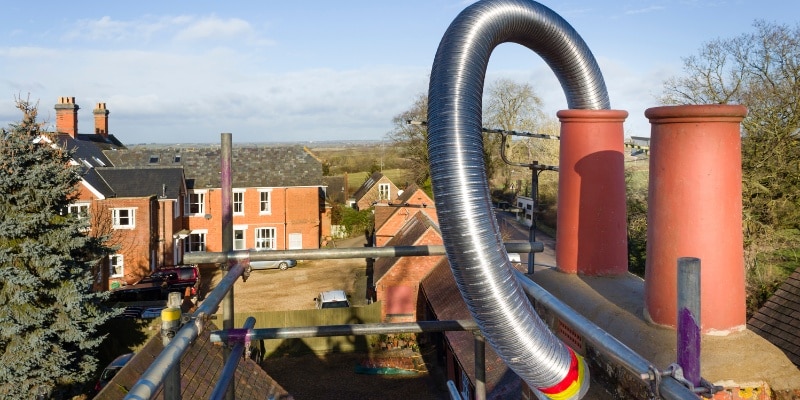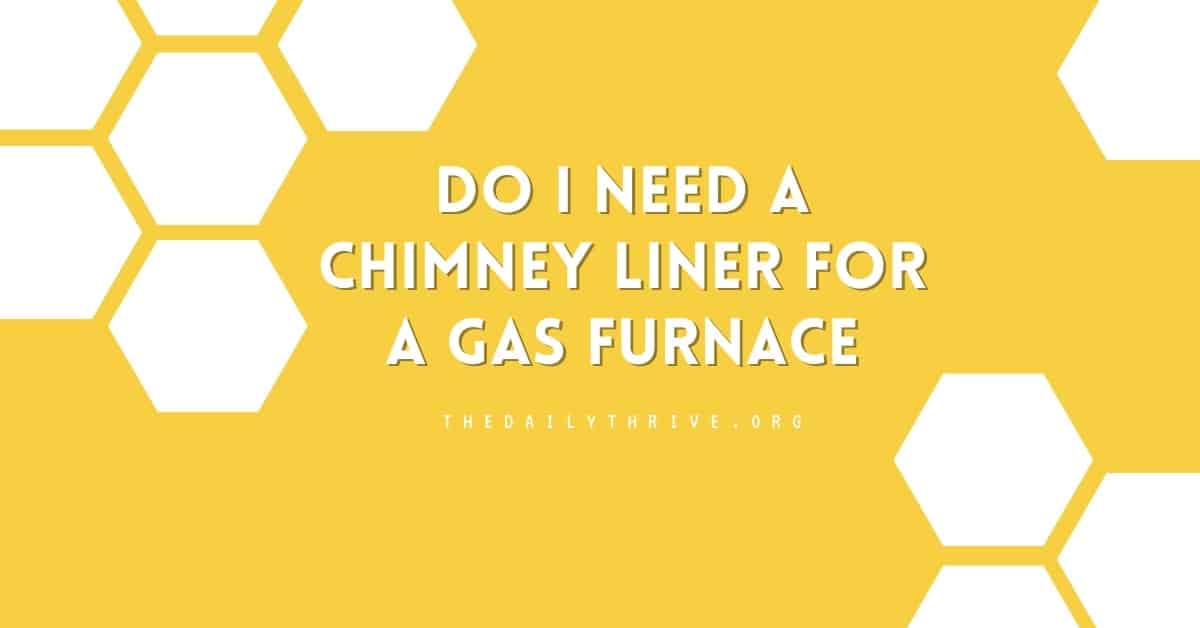Chimneys may seem obsolete since many of us no longer use the fireplace as our main heat source. You might wonder, “What and how are chimneys used then?” Great question! Their role largely depends on the type of furnace you have. Generally, chimneys serve as a ventilation pathway, expelling the byproducts from your furnace, primarily steam.
But here’s the catch: as time marches on, furnaces evolve, becoming efficiency models, and our chimneys must keep up with the Joneses. That’s where chimney liners come into play. So, let’s dive into the nitty-gritty of chimney liners and explore whether you need one for your gas furnace. Strap in because we’re about to uncover some HVAC truths that could save you from future headaches and hazards.
Understanding Chimney Liners
First off, let’s break down what a chimney liner is.
A chimney liner is a critical component within the chimney shaft. It is designed to maintain the safe and efficient operation of a fireplace, stove, or furnace. Its primary function is to create a barrier within the chimney, preventing the intense heat, hazardous gases, and other combustion byproducts from compromising the chimney’s structure and seeping into the living spaces of the home.

Chimney liners come in various materials, each serving a specific purpose depending on the type of appliance and fuel being used.
The most common types are:
- Clay liners: Traditional and cost-effective, these are found in older homes. While they are suitable for open fireplaces, they are not ideal for the higher temperatures and corrosive gases produced by modern gas furnaces.
- Metal liners: Usually made of stainless steel or aluminum, these liners are highly durable and flexible, making them suitable for furnaces that require a gas or oil flue. Stainless steel options are particularly corrosion-resistant, thus preferred for their longevity.
- Cast-in-place liners: These are lightweight, cement-like products installed inside the chimney, forming a smooth, insulated passageway for the gases. They enhance the structural integrity of aging chimneys while withstanding high temperatures and acidic byproducts.
The choice of chimney liner is crucial as it directly impacts the efficiency, safety, and longevity of your heating system. A mismatch between the type of liner and the heating appliance can lead to rapid deterioration of the chimney structure, potential carbon monoxide leakage, and, ultimately, a fire hazard within the home. Therefore, a technical understanding and professional assessment are necessary when considering the appropriate chimney liner for your setup.
The Necessity of Chimney Liners for Gas Furnaces
The fundamental role of a chimney liner in the context of a gas furnace operation is multifaceted. Firstly, the liner provides a protective barrier that shields the masonry of the chimney from the corrosive byproducts of combustion.
Gas furnaces produce a significant amount of water vapor and acidic gases, which can degrade the internal structure of an unlined chimney. Over time, this degradation can lead to structural instability, leaks, and, ultimately, failure of the chimney system.
Beyond structural protection, chimney liners contribute significantly to the overall performance and efficiency of a gas furnace. The liner’s diameter is crucial in maintaining proper draft in the chimney, which allows for the effective venting of combustion gases.
An appropriately sized chimney liner ensures that the volume of the flue is compatible with the furnace’s output capacity, preventing issues such as draft hindrance and the backdraft of hazardous gases into the living space. This optimization of the flue gas pathway is critical, as an oversized or undersized liner can impede the furnace’s efficiency, leading to increased fuel consumption and potential safety risks.
Moreover, the presence of a chimney liner aids in heat retention within the flue, which promotes a more consistent furnace operation and helps maintain optimal combustion conditions.
By keeping the flue gases warmer, the liner encourages a better draft in the chimney, reduces the likelihood of condensation and creosote buildup, and minimizes the risk of chimney fires.
While chimney liners are crucial for the safe and efficient operation of most gas furnaces, there are specific scenarios where you might not need to add a liner.
Here’s how those situations break down:
- Existing Chimney Liner: There is no need for an additional liner if your chimney already has a functional one. A visible metal pipe at the chimney top usually indicates its presence.
- Old, Inefficient Furnace: Extremely outdated furnaces may not require liners due to low efficiency. However, their continued use can lead to other maintenance and cost issues.
- High-Efficiency Furnace (90% AFUE or Above): Furnaces with 90% AFUE or higher don’t use traditional chimney liners. Instead, they need specialized PVC pipe ventilation systems that exit through the house’s side.
- Newer Home Specifications: Recent homes might already incorporate modern metal chimneys suitable for efficient furnaces, eliminating the need for separate chimney liners.
Professional consultations remain crucial to confirm these conditions and ensure your furnace’s safe and efficient operation.
Potential Risks of Not Using a Liner
Operating a gas furnace without a chimney liner poses significant risks, reflecting profoundly on both safety and operational cost aspects. Below are detailed insights into the potential hazards associated with neglecting the installation of a chimney liner:
- Structural Deterioration: Combustion byproducts can erode mortar joints, leading to structural issues in the chimney and potentially the home due to moisture intrusion.
- Fire Hazard: Heat transfer through an unlined chimney can ignite materials within walls, often undetected, until it’s too late, posing a severe risk of extensive property damage.
- Carbon Monoxide Poisoning: Without a liner, carbon monoxide from incomplete combustion may leak into the home instead of venting outside, presenting a fatal health hazard.
- Decreased Heating Efficiency and Increased Costs: Missing a chimney liner can cause rapid cooling and condensing of gases, leading to creosote buildup, poor venting, loss of heat, and higher fuel consumption, reflected in increased utility bills.
- Legal and Insurance Implications: Non-compliance with building codes requiring liners can bring legal penalties and potential denial of insurance claims for damages resulting from such negligence.
Given these substantial risks, installing a chimney liner isn’t a corner you want to cut. It’s an investment in safety, efficiency, and peace of mind. Neglecting this component can have dire, costly, and even life-threatening consequences.
How much does a chimney liner cost to install?
The cost of a chimney liner can vary widely based on several factors, including the type of liner, the dimensions of the chimney, the complexity of the installation, and regional pricing differences.
Here’s a general breakdown:
- Material Costs
- Clay liners: These are often the most affordable, with costs for the liner itself ranging from $10 to $50 per foot.
- Metal liners: Stainless steel liners, a popular choice for durability, can cost between $50 and $200 per foot. Aluminum liners, cheaper but less durable than stainless steel, can range from $25 to $75 per foot.
- Cast-in-place liners: These are generally the most expensive, potentially costing $2,000 to $5,000 for the entire job, depending on the chimney’s size and condition.
- Installation Costs
The labor for installing a chimney liner is an additional cost and can vary significantly. It often starts at around a few hundred dollars. Still, it can go up to several thousand, depending on the work’s complexity. - Additional Costs
If your chimney needs cleaning or repair before the liner can be installed, this will be an additional cost. Also, customizations or adaptations, such as insulation around a metal liner, can add to the final price.
Considering all these factors, a chimney liner installation’s total cost can range from as low as $700 to $1,750 for a simple setup in a small chimney to $2,000 to $8,000 or more for a larger, more complex job.
Given these variables, it’s highly advisable to get several quotes from different service providers in your area and ensure they conduct a thorough inspection before providing a final estimate. Also, investing in a quality liner and installation can save you from higher repair costs and provide added safety for your home.
Legal & Safety Standards
Don’t just take it from me. There are legal codes and safety standards in place emphasizing the importance of chimney liners. Depending on where you reside, specific regulations govern this aspect because, let’s face it, safety is paramount.
These regulations are in place to prevent fire hazards and toxic gas infiltrations within residential structures.
- National Fire Protection Association (NFPA): The NFPA 211 (Standard for Chimneys, Fireplaces, Vents, and Solid Fuel-Burning Appliances) is the preeminent standard in the United States. It stipulates that all masonry chimneys must have a liner to uphold structural integrity and fire safety. The code is adamant about the conditions under which liners must be replaced or repaired, particularly if the existing liner is cracked, crumbling, or otherwise deteriorating.
- International Residential Code (IRC): The IRC, adopted in many jurisdictions across the U.S., mandates that a chimney serving a gas-fired heater or appliance must be lined. Unlined chimneys or those with eroding masonry cannot be used for exhaust venting, as they pose significant safety risks.
- Local Building Codes: Besides national standards, many local building codes enforce specific requirements for chimney liners. These ordinances vary by municipality and state, but their emphasis is uniform: ensuring safe and efficient operation. Homeowners must often obtain relevant permits and subject the installation to subsequent inspections.
- Insurance Compliance: Beyond legalities, homeowners’ insurance policies generally require compliance with safety standards and building codes. Non-compliance can lead to the invalidation of home insurance claims relating to any fire incidents or structural issues caused by an inadequate or absent chimney liner.
Given these standards, homeowners must consult a professional HVAC technician when installing, replacing, or repairing chimney liners. Regular inspections by certified professionals ensure compliance with legal and safety standards, keeping the home safe and legally compliant.
So, circling back to the big question: Do you need a chimney liner for your gas furnace? Absolutely. It’s a shield, a performance enhancer, and a legal buddy.
My two cents? Always consult a professional. Because when it comes to the safety and efficiency of your home, second-guessing shouldn’t be an option.






